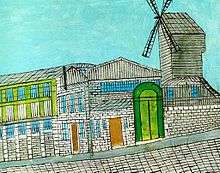Louis Vivin
Louis Vivin (born 28 July 1861, Hadol, France; died 28 May 1936 in Paris) was a French primitivist painter.

Biography
Vivin was self-taught and a representative of naïve painting. He showed great enthusiasm for painting as a child, but his career took him in a completely different direction: he worked as a postal clerk until 1922, pursuing his art only in his spare time.[2] Eventually, he was discovered by the German art critic Wilhelm Uhde (1874–1947), an association which helped him start exhibitions and build a reputation as a serious artist. When he worked in the postal service, his job was an inspector. Once he retired in the year of 1923, Louis Vivin finally took up the full-time part of being an artist.[3] His birthplace was in the city of Hadol, France. He moved to Paris, France in the year of 1889 where he lived with his wife in the district of Montparnasse.[4][5]
Works
The subjects of Vivin's paintings were still life, hunting subjects, and the city of Paris.[6] Vivin was a contemporary of Henri Rousseau, Camille Bombois, André Bauchant, and Séraphine Louis, known collectively as the "Sacred Heart Painters" and as masters of French naïve painting.[7] Vivin's works are known to have a sad and dismal theme to them. He was also known for painting from his memory. Louis Vivin was influenced by the work and details of Jean-Louis-Ernest Meissonier’s paintings. His works depicted genre scenes, flower pieces, hunting scenes and views of Paris, "notable for their charmingly wobbly perspective effects". [8]
Louis Vivin’s first one-man exhibition was placed at the Galerie des Quatre Chemins, and it was organized by Wilhelm Uhde in 1927.[3] His later work was considered to become less dependent of the melancholy mood, and it focused more on blocks of color and form.[4][5]
Lists of his selected artworks
Southampton City Art Gallery[9]
- Venice: Canal Scene with a Church
- La main chaude
- Les Invalides
- Venice: Canal Scene with a Bridge
Auction Christie's[10]
- La place des Halles et l'eglise Saint-eustache, Paris, 1935
- Sacre coeur
- Vue de sacre coeur
Private collections[11]
- Casino de Biarritz
- The Flower Market, 1914
- Gare Montparnasse, Paris
- Luncheon on the Grass, 1925
- Paris, Eglise de la Trinité, 1925
- Paris, Montmartre: Cirque Medrano, 1925
References
- "Le Moulin de la Galette, 1926 (oil on canvas)".
- Brodskaia, Natalia. Naive Art. p. 117.
- "Louis Vivin (1861–1936)". ArtFact. Retrieved 17 July 2013.
- "Louis Vivin (1861–1936)". Galerie St. Etienne art. Retrieved 17 July 2013.
- "Louis Vivin (French 1861–1936)". Feoli Fine Art. Retrieved 17 July 2013.
- Hamilton, George H. (1993). Painting and Sculpture in Europe: 1880–1940. pp. 226–227. ISBN 0300056494.
- Kallir, Jane. The Folk Art Tradition: Naïve Painting in Europe and the United States. pp. 42. ISBN 067032325X.
- Louis Vivin Retrieved on 28 Feb 2018
- Louis Vivin Retrieved on 28 Feb 2018
- Some works of Louis Vivin Retrieved on 28 Feb 2018
- Louis Vivin - Artworks Retrieved on 28 Feb 2018